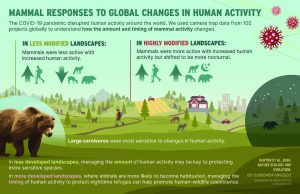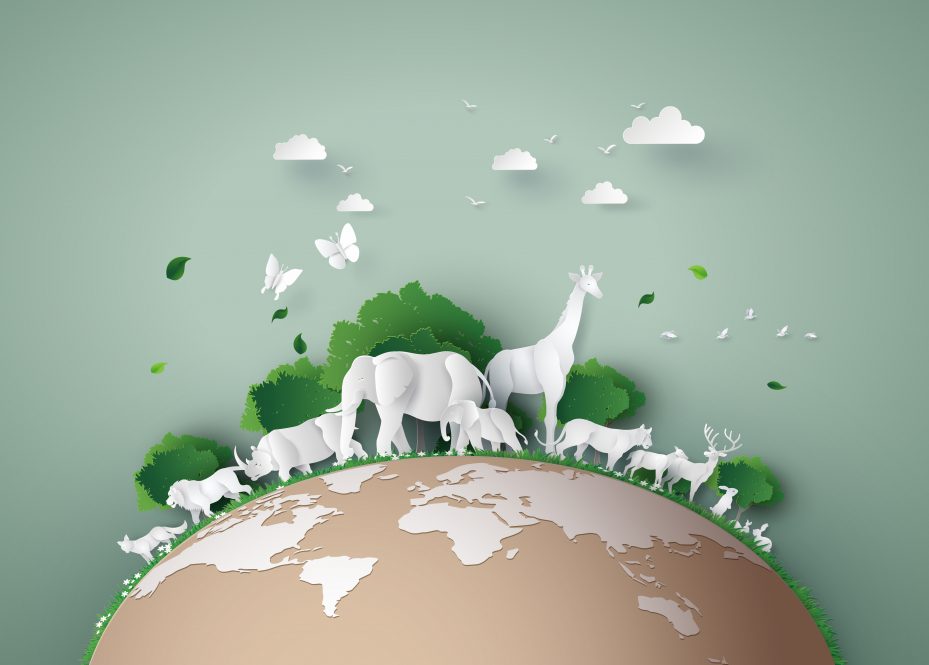One of the largest studies on wildlife activity—involving more than 220 researchers, 163 mammal species, and 5,000 camera traps worldwide—reveals that wild animals react differently to humans depending on where the animals live and what they eat.
Bigger herbivores—plant-eating animals like deer or moose—tend to become more active when humans are around, while meat-eaters like wolves or wolverines tend to be less active, preferring to avoid risky encounters.
Urban animals like deer or raccoons may become more active around people, as they get used to human presence and find food like garbage or plants, which they can access at night. But animals living farther from cities and other developed areas are more wary of encountering people.
The new study, a collaboration of researchers from 161 institutions, including CT State Museum of Natural History Curator, Collections Manager, and Engagement Specialist, and UConn Biodiversity Research Collection Vertebrate Collections Manager Erin Kuprewicz, Associate Professor in Residence in UConn’s Department of Ecology and Evolutionary Biology Miranda Davis, and Fulbright scholar Joan Tremblay ’22 (CLAS) used comparative camera trapping data from pre-lockdown and post-lockdown from sites across the globe, including study sites in Storrs and Nye Holman State Park, CT, to track how animals responded to the COVID-19 ‘anthropause’.
“COVID-19 mobility restrictions gave researchers a truly unique opportunity to study how animals responded when the number of people sharing their landscape changed drastically over a relatively short period,” says lead author Cole Burton, an associate professor of forest resources management at the University of British Columbia. “And contrary to the popular narratives that emerged around that time, we did not see an overall pattern of ‘wildlife running free’ while humans sheltered in place. Rather, we saw great variation in activity patterns of people and wildlife, with the most striking trends being that animal responses depended on landscape conditions and their position in the food chain.”

In Canada, researchers monitoring areas such as Banff and Pacific Rim national parks, Cathedral, Golden Ears, and South Chilcotin Mountains provincial parks, and the Sea-to-Sky corridor in B.C. found that carnivores like wolverines, wolves, and cougars were generally less active when human activity was higher.
In several of these parks, and in cities such as Edmonton, large herbivores often increased their activity but became more nocturnal with the presence of more humans. Large carnivores were notably absent from the most human-dominated landscapes.
Kuprewicz and Davis collaborate with researchers and citizen scientists across the country in a coordinated national survey called Snapshot USA which tracks and inventories animal activity. As a participant in Snapshot USA, Kuprewicz and Davis lead a long-term mammal census projects studying the mammals of rural Connecticut. This massively collaborative project involves over 100 collaborators from every state in the USA and has been running in Storrs and nearby Nye Holman State Park every fall for the past five years.
In Eastern Connecticut, the researchers saw similar patterns to those observed in Canada,
“Some of the highlights specific to my dataset were that we noticed woodchucks significantly increased their activity at Storrs sites when humans are active, but bobcats and skunks significantly decreased their activity. These local trends match up with the global patterns we present in the paper.”
Large carnivores were the most sensitive to higher levels of human activity and generally shifted activity to nighttime – one way to avoid contact with humans. Davis adds,
“We know from Joan Tremblay’s research, here at UConn, that additionally there is variation among carnivore species, and the unique aspects of their biology influenced their responses to human activity. Joan found that fishers (Pekania pennanti) were particularly sensitive, becoming more active when human activity decreased; this is in keeping with their reclusive nature. These responses are important to tease apart and understand because carnivores have a heightened extinction risk due to their position at the top of food chains, their large space requirements and potential for conflict with humans. Knowing how they respond to human activity could help carnivores and humans to better coexist.”
Why it matters
These findings highlight the importance of measures to minimize any detrimental effects of human disturbance on wildlife, including reducing overlaps that might lead to conflict.
“In remote areas with limited human infrastructure, the effects of our actual presence on wildlife may be particularly strong. To give wild animals the space they need, we may consider setting aside protected areas or movement corridors free of human activity, or consider seasonal restrictions, like temporary closures of campsites or hiking trails during migratory or breeding seasons,” says study co-author and UBC biologist Kaitlyn Gaynor.
She adds that strategies must also fit specific species and locations. In more remote areas, keeping human activity low will be necessary to protect sensitive species. In areas where people and animals overlap more, such as cities, nighttime is an important refuge for wildlife, and keeping it that way can help species survive. Efforts may focus on reducing human-wildlife conflict after dark, such as more secure storage of trash bins to reduce the number of animals getting into human food sources, or use of road mitigation measures to reduce vehicle collisions.
“Being aware of what mammals are active and when around UConn allows us to be thoughtful in campus planning to avoid detrimental human-wildlife conflict,” says Kuprewicz. “My cameras have shown that green spaces throughout campus are surprisingly rich in carnivore species (e.g., bobcats and fishers). The potential to evaluate these spaces as effective wildlife corridors in a human-dominated college campus landscape is exciting.”
The findings are particularly useful amid the surge in global travel and outdoor recreation post-pandemic, Burton adds.
“Understanding how wildlife responds to human activity in various contexts helps us develop effective conservation plans that have local and global impact. For that reason, we are working to improve wildlife monitoring systems using tools like the camera traps that made it possible to observe animal behaviors during the pandemic.”
The researchers say collaborations and data sets like these are vital for navigating our future. According to Davis, “Mammals, and carnivores in particular, can have large territories and are often shy, making it hard for researchers to observe them directly. Large data collaborations using remote camera traps like this one (Snapshot USA) are ground-breaking for mammal ecology research and conservation.”
Providing perspective for future work, Kuprewicz adds,“As we accrue more census years for our long-term mammal dataset and devise interesting ways to use these data, the story of shifting species activity patterns and ranges will become clearer in the ever-changing Anthropocene.”



